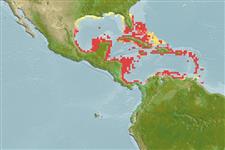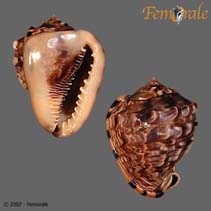Cassis flammea (Linnaeus, 1758)
Flame helmet| Native range | All suitable habitat | Point map | Year 2050 |

|
| This map was computer-generated and has not yet been reviewed. |
| Cassis flammea AquaMaps Data sources: GBIF OBIS |
Classification / Names Common names | Synonyms | CoL | ITIS | WoRMS
Gastropoda | Littorinimorpha | Cassidae
Environment: milieu / climate zone / depth range / distribution range Ecology
Benthic; depth range 1 - 12 m (Ref. 83435). Tropical; 32°N - 9°N, 94°E - 60°E (Ref. 83435)
Distribution Countries | FAO areas | Ecosystems | Occurrences | Introductions
Western Atlantic.
Length at first maturity / Size / Weight / Age
Maturity: Lm ? range ? - ? cm Max length : 15.4 cm DL male/unsexed; (Ref. 83435); common length : 7.5 cm TL male/unsexed; (Ref. 355)
Short description Morphology
Shell large, heavy. Spire short. Shell surface smooth, except for knobby projections on body whorl. Parietal shield large and well defined, oval. Outer lip with inner tooth-like projections. Colour: brownish cream with large patch of brown at centre of parietal shield. Outer lip entirely cream or cream-white.
On sand bottoms near seagrass beds, at shallow subtidal depths (Ref. 355).
Life cycle and mating behavior Maturity | Reproduction | Spawning | Eggs | Fecundity | Larvae
Members of the order Neotaenioglossa are mostly gonochoric and broadcast spawners. Life cycle: Embryos develop into planktonic trocophore larvae and later into juvenile veligers before becoming fully grown adults.
Main reference
References | Coordinator | Collaborators
Leal, J.H. 2003. (Ref. 355)
IUCN Red List Status (Ref. 130435)
CITES status (Ref. 108899)
Not Evaluated
CMS (Ref. 116361)
Not Evaluated
Threat to humans
Human uses
Fisheries: commercial
| FishSource |
Tools
More information
Internet sources
BHL | BOLD Systems | CISTI | DiscoverLife | FAO(Publication : search) | Fishipedia | GenBank (genome, nucleotide) | GloBI | Gomexsi | Google Books | Google Scholar | Google | PubMed | Tree of Life | Wikipedia (Go, Search) | Zoological Record
Estimates based on models
Preferred temperature
(Ref. 115969): 26.3 - 28.2, mean 27.4 (based on 425 cells).
Price category
(Ref. 80766):
Unknown.



